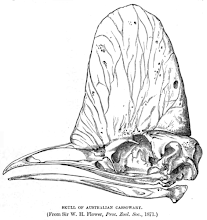okay, when i say parasite, what comes to mind?
 ticks?
ticks? caterpillar hijackers?

scott disick of i-got-kourtney-kardashian-pregnant fame?
well i'll tell you what, when i hear the word parasite, i think of this:

wow, something bird related. weird!
look closely at the above picture, and you'll notice that the bigger bird is getting fed by the smaller bird. what's up with that?
well, this is no episode of "maury: my 10 month old baby is one hundred pounds" or whatever.

yeah that's really not the case here.
instead, something way cooler is happening: brood parasitism! in the above picture, what is portrayed is a young brown-headed cowbird being fed by a yellow warbler.
brown-headed cowbirds are birds in the blackbird family (Icteridae) that live in the great plains of north america, and though they lay their own eggs, they sure as hell don't want to take care of their babies.
i wouldn't either; baby cowbirds are seriously ugly and seriously altricial.

i guess taking care of babies takes a LOT of energy, because you have to provide everything for them, like:
-food
-shelter
-rides to their friends' houses
to save on energy, brood parasites [like cowbirds] have evolved a simple behavior that solves the problem of actually having to raise their own young:
[forced] adoption!

actually, forced adoption is a really nice term for what brood parasites do. Essentially, parasites, like the common cuckoo,
 greater honeyguide,
greater honeyguide,
and brown-headed cowbird,

lay their eggs in other species' nests.
this behavior usually translates into some pretty bad things for the host species, including, but not limited to:
1. their own babies dying
but aubrie, why do the host species babies die? can't the introduced young [cowbird, i.e.] and the host young live together happily?
well, simply put...NO

that would be a brown-headed cowbird hogging the bed AND the sheets.
generally, a brood parasites' young hatch earlier and grow at a faster rate than the host's young, and end up out-competing the host babies for food and room in the host nest.
great deal for the baby parasite, bad deal for the host baby.[bad deal like starvation and death]

way short straw deal
the thing about parasite eggs is that they are often hard for hosts to identify as parasite eggs. a lot of the time, birds figure: "well, it's in my nest, musta laid it!" and go on with their lives as if the egg was their own.
and when it hatches, i mean, you have to love your kids no matter what, right?

so, okay, birds aren't going to get rid of eggs they think are their own. and if the parasitic eggs "come to term" as it were, then they're going to get fed and thrive instead of the host species babies.
in fact, to really get the upper hand, the parasites might even get rid of the host eggs themselves:
what lies! what trickery! how treacherous! dang!
yet, there is hope for the hosts.

unfortunately, this hope comes via more baby and egg killin'

as parasites have developed behaviors to lay their eggs in other species' nests, some species have evolved counter-parasite protection plans. for example, the yellow warbler:

when the yellow warbler recognizes there is a foreign egg in its nest, it just builds a new nest to lay eggs in on TOP of the old one.
other birds, like catbirds, just get really angry and throw the eggs outta the nest. sometimes, in their fervor, they actually eject their own eggs out of the nest, too. whoops!

though it provides protection against the invaders, egg recognition and ejection is not the end of this evolutionary battle.
in fact, it is just the beginning.
to prevent host species from recognizing their eggs, cuckoos have developed the ability to lay eggs that look extremely similar to the host's eggs. check it:

the bottom eggs are the impostors. WOW!! that will make it hard to tell.
but aubrie, let's get real. birds can't do stuff like they're in some sort of technological war! they don't even have thumbs or laptop computers.
WRONG! [well, right about the thumbs and laptops bit, maybe] to illustrate and expand your brain, let's have a little evolutionary theory with a side of humiliTEA.

the phenomenon i've been describing to you has often been called an evolutionary arms race, because no matter what one species does to either:
take advantage of [parasite]
-or-
defend themselves [host]
the other will respond [evolutionarily] to keep the status quo.
it's called the red queen effect, after a quote by louis carroll in alice in wonderland.

relatively, though there is evolutionary change in the species, there is no net gain of one species over the other in the given interaction.
graphically, the interactions of host-parasite can be represented with a simple population frequency/generations graph:

more individuals of the host in one generation causes greater success of the next generation of parasites. eloquent!
otherwise, the red queen effect can be represented in terms of fitness.

okay, don't get scared like i do when i see graphs [especially when they're small and black and white. b0ring, i like a little more PiZaZz.]
anyway, all the graph is demonstrating is that:
1. as the adaptiveness of the prey goes up
2. the exploitation of the prey by the predator goes down
basically, it's harder to be a predator when your prey knows all your tricks!
so, the predators eventually learn new tricks.

not quite
for our birds in evolutionary terms:
parasite learns to lay eggs in host nest to save energy--> host bird learns to recognize and eject parasite eggs to save babies --> parasite young ejects host eggs instinctually to out-compete host babies--> ?
looks like it's the host's move to defend...wonder where they'll move the red queen next?!

